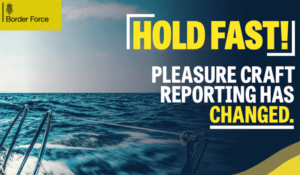
UK launches new reporting service for overseas boat voyages

The UK Border Force has developed a new digital reporting service for those travelling to and from the UK on pleasure craft to report their journey.
The new online service is known as single Pleasure Craft Reporting (sPCR), and replaces the previous ‘C1331 Form’ that has been enforced since 1 January 2022.
Since 1 January it has been a legal requirement to report your departure from and arrival in the UK by pleasure craft. Anyone who owns, or is responsible for, a pleasure craft that sails to or from locations outside the UK and the Isle of Man is required to provide information about:
- The vessel
- The voyage
- Individuals on-board
- Goods documentation
The new Pleasure Craft Report Service (sPCR) helps maximise maritime border security while making it faster and easier for those travelling on pleasure craft to report the necessary information in advance of travel to or from the UK. The new digital pleasure craft report is a one-stop service, recording all necessary information for both Border Force and HMRC.
The previous C1331 Form can still be downloaded and posted if required. However, wherever possible, Border Force says it encourages the use and promotion of the new digital service.
If you need to make a report using a mobile phone or tablet, the sPCR should now provide a viable mechanism for doing so. The process will still be dependent on having internet access, but your vessel details, details of the people on board and your passage information can be added and saved in advance, so you just make any necessary amendments and submit the report.
Reporting using sPCR replaces the submission of the C1331 (or eC1331) but all other procedures e.g. flying the Q flag (unless you are arriving from an EU member state into Northern Ireland) remain. You can find further information about these procedures on the entry and exit formalities page on the RYA website.
“The Cruising Association has been liaising with UK Border Force for a number of years on this project with a view to ensuring that the new system fits the needs of the cruising community,” says Derek Lumb, president of the Cruising Association. “Together with the RYA, British Marine and other marine organisations, CA representatives have attended and been active in discussions at the general maritime leisure sector liaison meetings in order to influence a positive outcome for cruisers.
“The change to a new online service delivers a far more accessible and user-friendly experience, making it easy to log new and alter existing passages.”
For those concerned about giving estimates of departure and especially arrival time, the ‘beta’ version allows a two-hour range.
The Cruising Association has discussed with UK Border Force the difficulty of giving relatively precise arrival times at the end of longer passages, and the UK Border Force advice is to give your best estimate and then update your report if you believe that either your arrival place will change, or the time will be outside the range you gave. Data can be updated online or skippers can telephone the appropriate UK Border Force operational centre for the area of arrival as soon as the boater can reasonably do so.
The voyage plan must be submitted at least two hours, but no more than 24 hours, before departure.
Lumb adds: “UK Border Force has stressed that this is not the final online version, and some changes are likely to be made in the light of experience.”
Pleasure craft arriving to the UK from outside the UK (including the Channel Islands) must fly the ‘Q’ flag as soon as entering UK waters (the 12-mile limit), and unless told otherwise by Border Force, boaters should call National Yachtline on arrival. The ‘Q’ flag must remain flying, and all crew must stay on board until the owner has received clearance from a Border Force officer.
